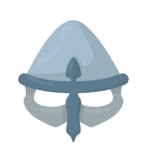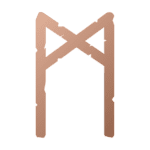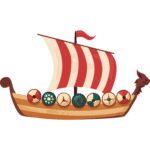Vikings Facts for Kids
Check out these amazing Vikings facts for kids! Become an expert on the Vikings in no time. From gods and goddesses to longships, there is so much to learn.
Check out these amazing Vikings facts for kids! Become an expert on the Vikings in no time. From gods and goddesses to longships, there is so much to learn.


Viking helmets were typically made of metal, such as iron or bronze and were used for protection during battle. They were typically simple in design, consisting of a dome-shaped cap with a metal band around the base to protect the ears and a nasal guard to protect the nose.
However, it is important to note that there is no historical evidence that vikings used helmets like the popularised winged helmet. This image is mostly a representation of Vikings in popular culture and not based on any historical findings. The helmet was typically worn with a chain mail or padded linen coif to provide additional protection for the neck and head.


The Viking language is also known as Old Norse and it was spoken by the Vikings during the Viking Age (8th – 11th century AD). It is a Germanic language that evolved from the Proto-Norse language and is closely related to other Germanic languages such as Old English and modern-day German.
The Viking language was divided into two dialects: West Norse and East Norse, which corresponded to the Vikings from Norway, Iceland and Greenland and the Vikings from Denmark and Sweden respectively. Many Viking sagas were written in Old Norse and it is still studied today by scholars and enthusiasts of the Viking culture.


Vikings were known for their longships, which were called “drakkars.” These boats were designed to be fast and maneuverable, which made them perfect for exploring new lands and raiding coastal towns.
They were also used in battles, as they could hold up to 60 men and were equipped with oars and a sail.
Vikings believed in gods such as Thor, Odin and Freyja. Thor was the god of thunder, and he was known for his strength and courage. Odin was the god of wisdom and war, and Freyja was the goddess of love and fertility.
Vikings believed that these gods controlled the fate of individuals and nations.
The Vikings had a complex society with kings, earls, and freemen. The king was the leader of the community and was responsible for making laws and leading the military.
Earls were nobles who controlled large areas of land and freemen were commoners who owned their own land and property.
The Vikings were also known for their use of the Icelandic sagas, a form of storytelling.
These sagas were passed down through generations and told the stories of legendary Viking heroes and their adventures.
Viking society not only consisted of warriors but also farmers, blacksmiths and other craftsmen. They had a complex social structure and a rich culture, which is still studied and admired today.
Vikings were also known for their seafaring and voyages to foreign land. They discovered and settled in North America more than 500 years before Columbus. They called the land Vinland.
Viking warriors, also known as berserkers, were known for their fierce and ruthless fighting style. They would often fight in a trance-like state, and were said to be immune to pain and fear. They were also known for their distinctive battle attire, which included bear or wolf skins, and they were often feared by their enemies for their strength and ferocity in battle.
They were the elite force of the Viking army, and were highly respected and honoured in Viking society.
The Vikings were eventually defeated by the Normans in the 11th century. The Normans were a group of Viking settlers who had settled in northern France and become a powerful force.
They conquered England in 1066 and eventually defeated the Vikings in their own lands.